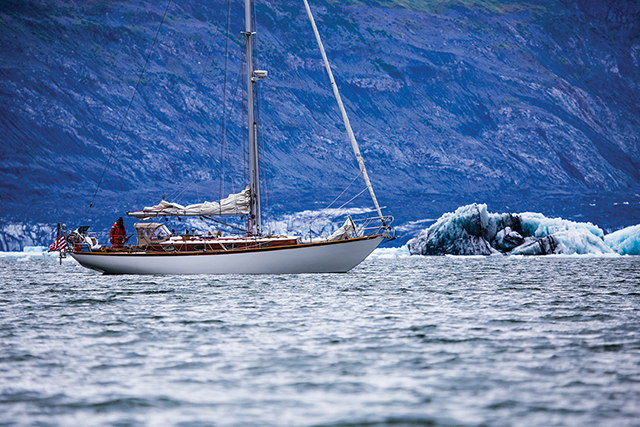Preparing a boat for an ocean voyage is a big process, and it requires even more effort and planning if you intend to cruise the world’s higher latitudes (published October 2015)
I’ve refitted three boats now: for a circumnavigation, for a U.S. East Coast trip and for the Bering Sea and Arctic. Each case was different because each boat and each voyage was different, although that’s not to discount the importance of a high safety standard in any refit. So what are these differences and how should they affect your outfitting? Of course, it’s impossible to cover every consideration here, especially the less tangible elements of mental stamina, effective risk evaluation, flexible plans and contingency plans. So I’m sticking to the boat herself. For simplicity’s sake, I’ve broken the outfitting precautions into four challenges presented by high latitude sailing: weather, ice, staying warm and lack of supplies.
WEATHER
Higher latitudes tend to have less fine weather and less predictable bad weather than lower latitudes. Approaching the Bering Sea, I found that forecasts were only reliable for 24 hours and sometimes much less. Between the rapidly moving fronts and the micro-climates of the islands and mountains, it was hard to predict. The lows also tend to be more severe (excepting hurricanes, of course): a gale I encountered while sailing to Fiji from New Zealand had sustained 40-knot winds, whereas this past August in the Gulf of Alaska, the forecasts often mentioned 50-knot winds, which is an average. Finally, gales are more frequent. Those Gulf of Alaska forecasts lasted an entire month with only the smallest breaks, often less than 24 hours.
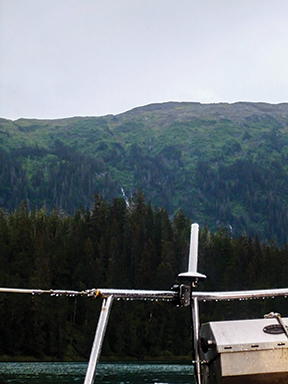
When outfitting for severe weather, the first consideration is avoidance. Don’t overlook the humble VHF radio, especially if you’re sailing to Alaska or Canada. Both governments provide excellent forecasts over VHF. A single sideband radio is a good idea as well, so that you can receive these same forecasts at longer range.
HF signals are weak or non-existent in the Arctic, however. So too are signals from most satellite communications providers, making Iridium the only option in the far north. The set-up is slightly more expensive than the SSB and Pactor modem but it’s worth it to have reliable communications. My Iridium phone hooks up to an external high latitude antenna from OCENS on the stern pulpit; it never dropped the signal even when surrounded by mountains. To connect to my computer, I use a router which creates a Wi-Fi hotspot and a firewall that blocks unwanted traffic and thus keeps airtime to a minimum. I found it easier to install than our SSB and also incredibly simple to use. For software, I use OCENS WeatherNet, which compresses weather files for practically instant delivery. WeatherNet also delivers ice charts, a key consideration for the Arctic.
No matter how good your forecasting set-up, you will almost certainly encounter inclement conditions on a high latitude voyage. Being at sea for an extended time makes it likely that at least one storm or gale will hit you. Furthermore, you might have to set out in heavy weather simply because it’s either not going to change or only going to get worse. This happened to me three times on my voyage to the Bering Sea.
Preparation for this starts with your boat’s design. As for any voyage, the boat’s angle of vanishing stability should be high: Peter Bruce in Heavy Weather Sailing recommends 140 degrees. Also important for high latitudes is windward ability. You don’t want to be on a lee shore in this kind of weather and not be able to claw your way off. The engine can help but isn’t the answer: almost all sailboats are designed to sail better than they motor. Having a fast boat is also advantageous since fast passages decrease the probability of meeting a storm.
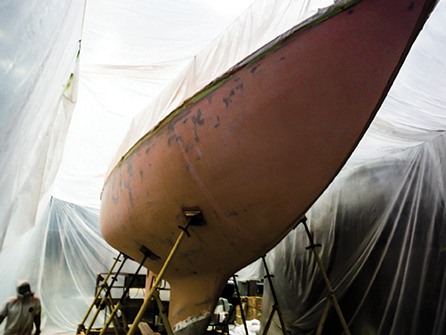
Yacht design aside, how to increase your safety margin? I first made sure my hull, rigging, and steering were strong and sound. If your hull is metal, check that it’s free of corrosion. If it’s fiberglass, be certain it’s free of osmosis and that it was built with enough resin originally. Except for considerations about ice, I was happy with my cutter’s cold-molded hull. She was custom built, so no expense was spared on resin and high quality veneers. She was due for a new barrier coat, however, so I took the opportunity to add two layers of fiberglass—standard practice when building cold-molded boats today but not when my cutter Celeste was built in 1986—and a layer of Kevlar. My primary motivation was to strengthen the hull for ice and provide better abrasion resistance, but the dividend was that Celeste became stiffer and even better able to stand up to foul weather.
The entire rig was replaced before embarking. For any offshore passage, we prefer to have redundant rigging, an inner forestay and running backstays, which also allows more sail combinations.
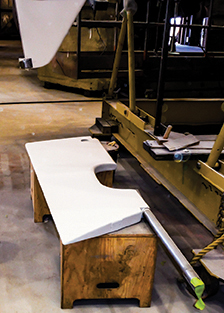
Dropping the rudder to check the steering and rudder post is a good idea, as is having an emergency tiller if you have wheel steering. Both this and checking the rigging are important for all voyages, but especially for the more inhospitable parts of the globe.
Reducing windage, and what I call ‘cruiser stern’(lots of stuff piled on the stern pulpit or an arch) is another good idea. Not only does the arch and the stuff increase windage, the stuff can hurt you if dislodged by a wave.
Finally, you want to have the gear to help you through. Storm sails—storm jib, storm staysail, working staysail, and trysail—are essential because you need to be able to sail through gales, both to continue on your voyage and to avoid obstructions to leeward. A drogue or sea anchor to slow your boat in extreme weather and breaking seas is equally important. I opted for the Jordan Series Drogue, comprised of over 100 cones strung out on a line terminating in a length of chain as a weight.
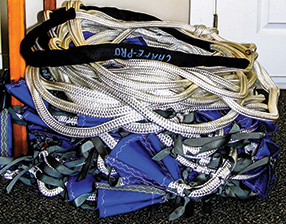
Last but not least, you want a good set of anchors. All sailors try to find the most sheltered anchorages, but many coves in high latitude places are deep and don’t have great holding. After watching a tractor test several different anchors on a beach in New Zealand, we became convinced by the ‘new generation’ anchors, and so have a 45 pound Mantus as our primary anchor, a 35 pound Mantus as stern anchor, and a 65 pound Mantus as storm anchor. The primary anchor is on 175 feet of chain, so as not to have rope at waterline in ice-prone waters.
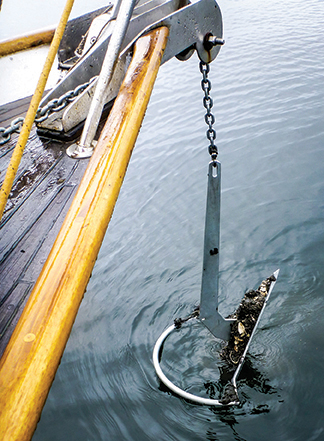
ICE
Like weather, your outfitting considerations for ice begin with avoidance. Canada and Alaska issue daily ice charts. OCENS WeatherNet provides many of these, and a family member compresses and emails the rest to us. Again, a good communications set-up is essential, as is careful observation of the changing conditions around you.
Metal is often the hull material of choice; high latitude voyagers Jimmy Cornell and Skip Novak both have custom metal yachts. But many impressive voyages have been made in plastic boats, notably Matt Rutherford’s Albin Vega 27 and British sailor Bob Shepton’s Dodo’s Delight, and even in wooden boats: Amundsen, after all, transited the Northwest Passage in a herring fishing boat.
Your rudder should be strong and preferably skeg-hung to protect it from damage. You’ll also want to remove your windvane’s rudder, or tilt it up well clear of the water. The ability to maneuver quickly, precisely, and at short notice is essential, which really means having a good auxiliary engine. Even Amundsen had a kerosene engine back in 1903. If your diesel is reluctant to start or has other problems, it’s a good idea to get it overhauled or even replace it. Thereafter, you’ll want to take good care of the iron mainsail; we keep Nigel Calder’s book and an enormous box of spare parts on hand. A spare propeller should be part of this equipment in case the original one gets damaged by ice.
Two important smaller items are ice poles and an electric anchor windlass. Ice poles, or ‘tuks’—a metal blade attached to a long pole—are used for pushing floes away from the boat, and an electric windlass helps tremendously for weighing anchor at a moment’s notice if currents and wind start to push ice into your anchorage. Finally, you’ll want warm clothing since you’ll be keeping a bow look-out or even climbing the mast to look for leads.
STAYING WARM
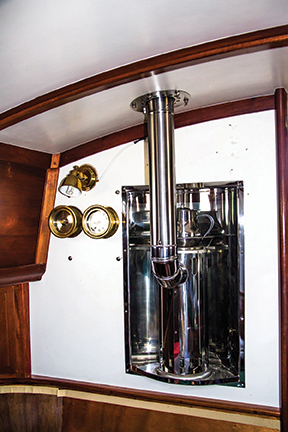
- This begins as a problem of comfort but can easily escalate into a safety problem when you start to think more slowly and have a harder time evaluating risks. An insulated hull is your first weapon against cold. If the hull condensates, you’ll battle moisture as well as cold. The next weapon is a heater. Celeste has three: a diesel stove-type, a forced air, and a ‘bus heater’ that runs off the engine. The bus heater is all we need when motoring; the Espar gets the temperature up quickly but uses electricity; and the stove-type makes the boat snug without electricity. Its only drawback is a tendency to go out in strong winds. All of this requires fuel, so you’ll need big diesel tanks and places to stow jerry jugs.Carry double the amount of propane you would for a tradewind voyage. Hot food keeps up morale and staves off seasickness; you’ll be surprised how often you light the stove. We blew through chili, pasta sauces, soups, hot chocolate, and—in bad weather—instant AlpineAire meals, dehydrated natural foods to which one need only add water. They were a big step up from our previous storm meals, US military rations.The easiest way to stay warm is with winter clothing: wool thermal tops and long underwear, sweaters, down jackets, gloves, hats, wool socks, insulated boots, and foul weather gear. You should also have a survival suit on board for every member of the crew: you won’t last long even in a life raft if you’re not protected in an immersion suit.
SUPPLIES
High latitude regions are isolated and sparsely populated. You won’t be able to haul out and get work done. So your boat must be in top shape before setting out. Not only the hull, rigging, engine, steering, communications, and heater, but all your systems. How is your plumbing and electrical circuitry? Are your batteries due for replacement? Celeste’s were, as was much of her wiring. We decided on AGM deep cycle marine batteries from Rolls, which use 60 percent recycled lead. They’re maintenance-free and aren’t position-sensitive (they can be turned upside-down in the event of a capsize). We try not to use the engine to charge because doing so decreases the engine’s lifespan, and maintenance headaches are the last thing we need. Many high latitude sailors opt for a diesel generator; we’ve used wind and solar (see BWS Nov. 2013). Everyone has different power needs and different opinions about charging options, so each sailor has to find the best solution for his boat. But you’ll need to have it working smoothly before departure.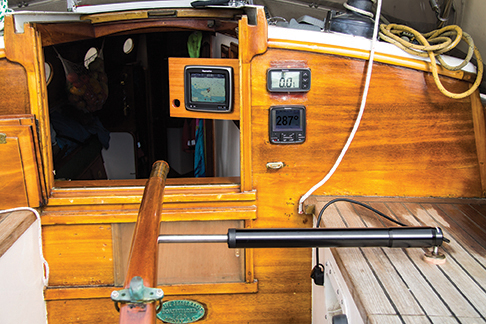
Celeste‘s autopilot, bidata instrument, and radar-chartplotter The same goes for electronics. We installed a basic GPS to use with paper charts when conserving power, a touchscreen chartplotter with radar, a depth/speed instrument, a new VHF with AIS, and an autopilot. Our windvane, however, is our primary self-steering device, just as it was on our circumnavigation when we had no autopilot at all. We wanted an autopilot for ice-strewn waters since we would be doing significantly more motoring.
For the fresh water system, we carry 100 gallons in two separate tanks, plus several jerry cans, and the smallest 12V desalinator on the market, the Katadyn 40E. This makes us completely self-sufficient, a comfort in such remote locations and in deserts like the Arctic where water is either very expensive or unavailable.
We carry all the safety items we’d have for any voyage: life raft, life jackets, jack lines, tethers, EPIRB, first aid kits, flares, hand-held VHFs, seacock plugs, bulldog clamps and a fully equipped ditch bag, to name a few. In the ditch bag we have a manual desalinator, the Katadyn 06. It hardly needs to be said that this would greatly prolong our lives should we have to take to the raft.
In addition to safety items, it’s important to make a thorough job of outfitting with spare parts, tools, and provisions, keeping in mind that these will be expensive or impossible to obtain in the isolated places to which you’re bound.
High latitude voyaging requires a degree of preparation that can seem daunting. But if you go about it methodically and stay realistic about the time it takes, you’ll set off with a sound boat and feel confident about doing so. That you’ve made the effort to prepare sufficiently will allow you to reap the rewards of your voyage, the awe-inspiring fjords, glaciers, mountains, and wildlife you’ve come so far to see. To know you’ve reached these places on your own keel is a feeling that’s worth all the months of preparation.
Circumnavigator, writer and photographer Ellen Massey Leonard splits her time between her classic cutter Celeste and working in Switzerland where she is completing a book about her voyage around the world at age 20. She most recently sailed from Washington State to Alaska’s Aleutian Islands and is continuing north to the Arctic in 2015. She was pleased to have Katadyn, Platypus Marine, Rolls Battery, OCENS Satellite Services, ZEAL Optics, and Mantus Anchors agree to sponsor her northern voyage. The 28-year-old chronicles her adventures at www.GoneFloatabout.com.

















